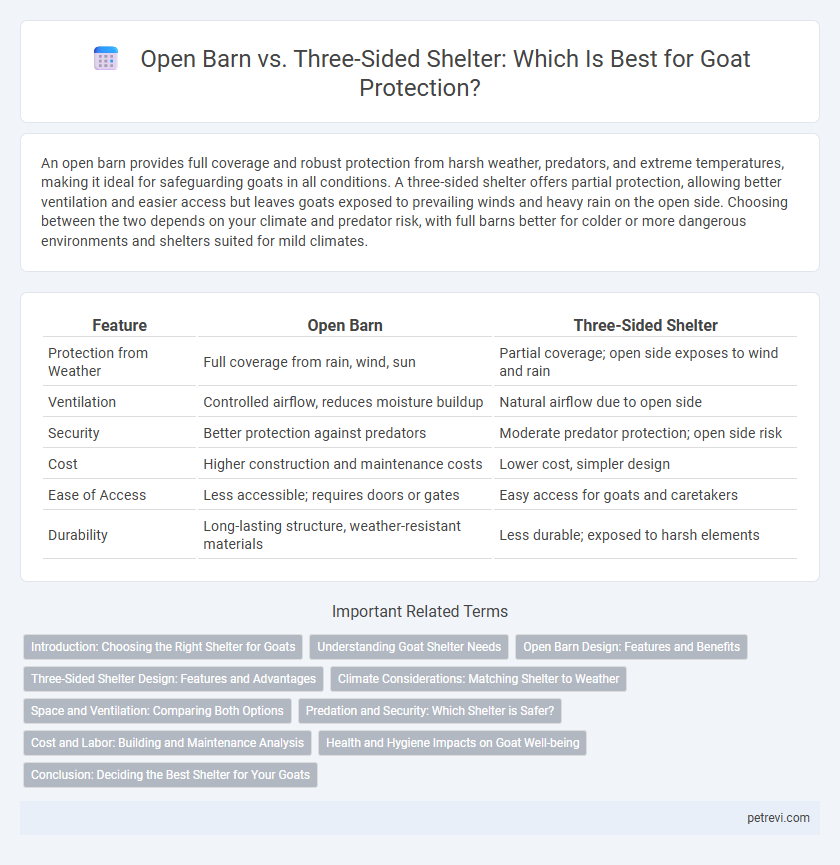An open barn provides full coverage and robust protection from harsh weather, predators, and extreme temperatures, making it ideal for safeguarding goats in all conditions. A three-sided shelter offers partial protection, allowing better ventilation and easier access but leaves goats exposed to prevailing winds and heavy rain on the open side. Choosing between the two depends on your climate and predator risk, with full barns better for colder or more dangerous environments and shelters suited for mild climates.
Table of Comparison
| Feature | Open Barn | Three-Sided Shelter |
|---|---|---|
| Protection from Weather | Full coverage from rain, wind, sun | Partial coverage; open side exposes to wind and rain |
| Ventilation | Controlled airflow, reduces moisture buildup | Natural airflow due to open side |
| Security | Better protection against predators | Moderate predator protection; open side risk |
| Cost | Higher construction and maintenance costs | Lower cost, simpler design |
| Ease of Access | Less accessible; requires doors or gates | Easy access for goats and caretakers |
| Durability | Long-lasting structure, weather-resistant materials | Less durable; exposed to harsh elements |
Introduction: Choosing the Right Shelter for Goats
Open barns provide goats with spacious ventilation and natural light, promoting health and reducing respiratory issues. Three-sided shelters offer protection from wind and rain while allowing easy access and visibility. Selecting the right shelter depends on climate conditions and goat breed needs to ensure optimum comfort and safety.
Understanding Goat Shelter Needs
Goat shelter needs prioritize protection from wind, rain, and predators while ensuring adequate ventilation and dry bedding. Open barns provide full enclosure, offering better protection against extreme weather and predators but may require ventilation adjustments to prevent humidity buildup. Three-sided shelters deliver effective windbreaks and rain cover while allowing natural airflow, ideal for goats in milder climates or supplemental shelter settings.
Open Barn Design: Features and Benefits
Open barn design for goats features open sides that enhance ventilation while offering shelter from rain and sun, promoting healthier respiratory conditions. The spacious layout allows for easy movement and natural light, reducing stress and encouraging social behavior among goats. This design is cost-effective, requires minimal maintenance, and can be adapted to various climates, providing durable protection throughout the year.
Three-Sided Shelter Design: Features and Advantages
The three-sided shelter design for goats provides effective protection against wind, rain, and extreme weather by blocking exposure on three sides while allowing ventilation through the open side. Constructed with durable materials like wood or metal, this shelter maintains a dry and comfortable environment, reducing stress and improving overall goat health. Its simple structure enables easy maintenance and flexibility in placement, making it an optimal choice for goat farmers prioritizing animal welfare and efficient space usage.
Climate Considerations: Matching Shelter to Weather
Open barns provide goats with excellent ventilation and protection from rain, making them ideal for hot, humid climates where airflow reduces heat stress and moisture buildup. Three-sided shelters offer partial protection from wind and snow, making them better suited for colder, dry environments where goats benefit from reduced wind chill while still accessing fresh air. Selecting the right shelter based on local climate enhances goat health by balancing exposure to elements and maintaining comfortable living conditions.
Space and Ventilation: Comparing Both Options
Open barns provide ample space and superior ventilation, promoting goat health by reducing moisture and ammonia buildup. Three-sided shelters offer limited airflow but can shield goats from prevailing winds while using less space overall. Optimal goat housing depends on balancing airflow needs with spatial constraints and climate conditions.
Predation and Security: Which Shelter is Safer?
Open barns provide comprehensive coverage and robust structural barriers, significantly reducing the risk of predator intrusion for goats. Three-sided shelters offer partial protection but leave one side exposed, increasing vulnerability to predators such as coyotes, foxes, and stray dogs. Security measures in fully enclosed barns, including lockable doors and reinforced walls, create a safer environment compared to the limited defense of three-sided structures.
Cost and Labor: Building and Maintenance Analysis
Open barns offer lower initial construction costs and require less labor compared to three-sided shelters, making them a more budget-friendly option for goat protection. Maintenance for open barns is typically less intensive due to simpler structural designs and easier access for cleaning and repairs. However, three-sided shelters provide better protection from wind and elements, which may reduce veterinary and health-related expenses in the long term despite higher upfront labor and material costs.
Health and Hygiene Impacts on Goat Well-being
Open barns provide ample ventilation, reducing moisture buildup and minimizing respiratory issues in goats, which supports overall health and hygiene. Three-sided shelters offer protection from wind and rain while allowing fresh air circulation, helping to keep bedding dry and reducing the risk of bacterial growth and parasite infestations. Both structures contribute to maintaining goat well-being by creating environments that prevent disease and promote cleaner living conditions.
Conclusion: Deciding the Best Shelter for Your Goats
Open barns offer excellent ventilation and spaciousness, promoting goats' health and natural behaviors, while three-sided shelters provide targeted protection from wind and rain with easier access for cleaning and monitoring. Considering regional climate, herd size, and specific goat breed needs is essential in selecting the ideal shelter to optimize comfort, safety, and maintenance efficiency. A balanced evaluation of environmental factors and goat welfare ultimately guides the decision between open barns and three-sided shelters for effective goat protection.
Open barn vs Three-sided shelter for Goat protection Infographic

 petrevi.com
petrevi.com